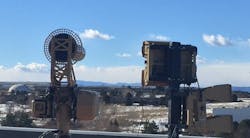When the terminal at Joslin Field, Magic Valley Regional Airport in Twin Falls, Idaho, was built 20 years ago, the process for boarding planes was drastically different.
Before the Sept. 11, 2001 terror attacks, airlines would check passengers in, run them through a metal detector and send them out to their flight. But after the attacks, Magic Valley like other smaller airports found itself in a situation where additional equipment and precautions were needed and the terminal didn’t have the space to accommodate it.
“Really the way the building was designed there was no checked bag screening area with a pretty elementary hold room that’s very small and post-9/11 we realized we have some constraints,” said Bill Carberry, manager of the airport. “Checked baggage is done in the lobby area, so that really cuts down on circulation and it’s not the most private of spots to do that and with all the new equipment TSA is bringing in, the checkpoint lane has taken over a lot of the area.”
Magic Valley broke ground on $4.3 million in enhancements to its terminal in April, which will remodel about 6,000 square feet of the terminal, add 8,000 square feet to the facility and improve the security of the airport. The project is expected to take about 10-11 months.
Preparing for the future
In May, George Bush Intercontinental Airport (IAH) opened up operations of its new exit lane breach control system, which is designed to alert security if a person or object tries to enter a restricted area.
Frank Pervola, business development manager for Tyco Integrated Security, said the system is designed to mitigate issues with wrong way entries into secure areas. Using video analytics interfacing to the system it can detect anyone trying to enter the wrong way.
While the installation had to be adjusted to work along slow times in the terminal, the payoff is expected in several areas.
“First off, there’s a cost associated because without it, the airport has to actually staff a person there 24 hours a day, seven days per week and that expense is another budget figure they have to put into their yearly allowance,” Pervola said. “By utilizing this electronic technology they get an return on investment in the first two to three years.
“The other thing is now that they don’t have that guard sitting at one post making sure no one enters, they could now put that guard out within the public confines of the traveling public. That’s going to them a lot more secure overall in the airport environment.”
Carberry said issues with the area has been known for a long time, but the airport needed to wait until it underwent its master planning process to proceed with changes.
He said the remodel will place the checked baggage screening area outside of the public area, create a new common room behind security and provide room for new TSA equipment.
One of the major enhancement with be the addition of a bathroom past the security checkpoint so people will not need to go through the checkpoint again if the utilize the facilities.
“That’s certainly the passenger amenity that’s long overdue,” he said. “It sounds like a small thing, but when you get junior in the room past security one of the first things they say is ‘mom I’ve got to go to the bathroom.’”
CSHQA was chosen as architect to design the project, with Petersen Bros. Construction serving as the general contractor for the project. Carberry said the airport used AIT funding for the project along with TSA, PFC and local dollars.
The project involved communication with a lot of different stakeholders, which Carberry said was coordinated by the airport and architect, which collected feedback to improve the process.
While there were no surprises in the planning process, Carberry said the community took notice of terminal upgrades, which isn’t normally found in airport improvement projects like pavement upgrades.
“It’s certainly a project that garners a lot of public attention,” he said. “People take a lot of pride in a community like Twin Falls in a project like this.”
He said they also planned for future expansion to accommodate different types of equipment to expand the checkpoint or if there’s a need for a second lane.
“I think it just places us in the place we need to be in the terminal,” Carberry said. “It’s really an evolutionary process we’re seeing with right-sizing TSA operations.”
Drones: a security threat
With the explosion in the unmanned aerial vehicles (UAV) and drone market, there are more reports of near-missed between drones and airplanes, and a growing concern about units breaching airfields.
Kenneth Geyer, vice president of operations and a cofounder of Liteye Systems Inc., said the current issues with UAVs are centered around hobbyists who don’t know the rules. However, there’s a growing concern that’s going around about critical infrastructure like airports being susceptible to a purposeful attack or sabotage with the use of one of these units.
“It sounds like a lot of hobbyists, but you almost feel from some of the stories I’m hearing that there’s a sense out there that there could be a more nefarious element to it and I think that’s going to grow,” he said. “You really get a sense that somebody is going to figure out how to bring an aircraft down with a UAV and once they do, that’s going to spread like wildfire through terrorist networks.”
Geyer said the massive footprint of an airfield and current radar systems not tuned in to look for a UAV creates a major problem in protecting airfields from a drone. Someone can park a vehicle nearby and launch a drone capable of carrying a 20-30 lbs. payload and it can be very hard to detect.
Geyer said there’s plenty that needs to be taken into account for defending against a drone and airport leaders need to really focus on who the facility is defending itself from. Many airports are worried about the hobbyists, but Geyer said the real threat are the people who are working to harm the airport and will use UAVs and even ground-based drones to attack.
Military installations are already set for UAV attacks, but now the civilian airports need to catch up.
“I think there’s a lot of misinformation out there,” he said. “This is a newer industry so there are a lot of misconceptions, so you need to know the abilities and the capabilities on the UAVs out there.”
Geyer said airports need to prepared to identify when and where someone is approaching the airfield vicinity and if they try to launch a drone. Quick identification of such a person can halt an attack and provide evidence for prosecution of someone entering the restricted area.
There are defensive applications for airports as well, but Geyer said right now that’s only being using in military applications and there are a few hurdles to get past the Federal Aviation Administration (FAA) before such a device is seen in the North American civilian airport market.
“The big part is being ready for what’s coming out down the road,” he said. “I think a lot people think ‘oh, it’s not that big of a threat, it’s years away,’ but I think they’re going to be sadly mistaken.”
Drones: a security solution
While airports are faced with tackling long lines in the terminal and getting people passed TSA checkpoints, new technology is emerging to handle outdoor challenges.
One such technology is the use of drones, which could fundamentally change airfield security.
“When we look at airport security and the role of drones, we see drones playing two roles as far as airport perimeter fencing and runway management are concerned,” said Ash Bhatia, COO of Eagle Eye Systems. “What we say is that these are large tracts of land that are becoming increasingly sensitive with recent events and managing the movement of goods and machines, and people in these tracts of land has become increasingly important.”
Bhatia said drones can keep tabs on the perimeter of an airport and alert staff of any issues that arise while on patrol. Using fleets of drones on the airport could allow concentration on certain issues the airport faces in addressing security and allows for continual observation when batteries run low on one of the units.
Thierry De Leeuw, chief technical officer for Eagle Eye Systems, said usage of image recognition in drone technology allows users to efficiently plan usage of the systems and better the security of the airport. Software can detect new things spotted on patrol and send an alert to the server and operations can be immediately notified of the issue.
The use of the technology would work similar to drone use currently in search-and-rescue missions or other law enforcement uses as it’s the same concept as use in airport security.
Drone or UAV usage also maintains a lot of data from missions. Bhatia said the captured data needs to be permissible as court evidence when an incident arises, so airports will need to plan on record keeping with the data.
The usage of drone can drive efficiencies in other areas, so airports also need to look at policies and how they’re implemented along with the training procedure with staff using drones.
“Work protocol and procedure is going to be even more imperative when adding something like this to your suite of capabilities,” Bhatia said. “It’s going to require much examination to procedures and process and training because these machines are not toys. They require a license to operate and fly.
De Leeuw said reports of near-miss incidents between UAVs and airplanes raises more questions for some airport officials looking into this technology, but issues can be addressed via training, setting parameters in the technology to create no-fly zones for the drones and server integration with the air traffic control tower so it has notification of the drone’s mission and where it’s going.
“Unfortunately in the industry today, the major players in commercial or open source platforms, I think they should really focus on adding those kinds of features into their software because today you can go to a shop and buy a multicopter, take off and without even realizing it fly into an area it’s not supposed to go,” he said. “A lot of people do it without bad intentions, but they should make sure you’re protected against doing that.”





